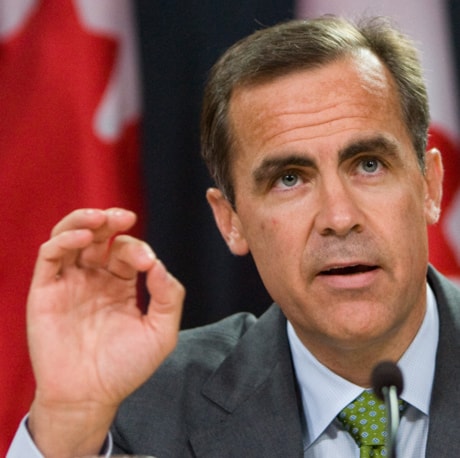OTTAWA — The Bank of Canada is declaring the recession essentially over, saying Canada’s economy will begin growing this summer after nine months of stagnation and lead most of the industrialized world next year.
The rosy assessment — despite numerous cautions and caveats — rippled through the markets Thursday, lifting the loonie and many stocks.
“We believe the economy will grow this quarter,” bank governor Mark Carney told a news conference. “Things are unfolding a little faster in terms of the recovery in (consumer and business) confidence and financial conditions.”
However, experts say the renewed growth after three quarters of economic shrinkage — two straight declining quarters is the technical definition of a recession — won’t lead to job growth until much later, when companies regain confidence and begin hiring again.
Earlier, the bank had dropped its April call for a one per cent contraction this quarter and now says the economy will instead expand by 1.3 per cent annualized.
That will be followed by a three per cent advance in the last three months of this year, and three per cent growth next year.
But Carney also issued a caution that recovery “is not a foregone conclusion,” and that the economy remains dependent on massive government stimulus and his own conditional pledge to keep the policy interest rate at the historic low of 0.25 per cent until mid-2010.
Without such interventions in Canada and around the world, economies would still be spiralling downwards, he said.
Even with recent improvements, Carney said the part of the economy that impacts Canadians most directly — jobs — will continue to deteriorate even as output perks up. Economists say that’s because employers are unlikely to take on new workers until they are certain demand will last.
“”It is going to be a tough, long, hard slog to get this country back to full employment and Mr. Carney is hinting at that we are not out of the woods yet,“ agreed, Liberal Leader Michael Ignatieff, repeating his call for expansion of employment insurance benefits.”
Statistics Canada calculates 370,000 jobs have disappeared since October, and some economists believe more than 500,000 will be lost before labour markets begin to recover.
While more optimistic than most forecasts, Carney concedes the bounce-back is modest by historical standards. In fact, he does not have the economy returning to full capacity until mid-2011.
Currently, the bank estimates the Canadian economy is operating 3.5 per cent below capacity.
Still, the markets chose to see the bright side of Carney’s new outlook.
The Toronto stock market surged more than 243 points Thursday, while the Canadian dollar gained more than a full cent on currency markets to close at 92.04 cents US.
The latter result won’t please the central banker, who again voiced his concern that a stubbornly high-priced loonie will cut into the recovery because it will price some Canadian exports out of world markets.
Many economists doubt that the central bank would intervene to reign in the loonie, however, although the bank’s governing council has not ruled out action.
Carney also said there remains a risk that the fragile financial systems in the United States and Europe may contain more unpleasant surprises, such as last September’s collapse of Lehman Brothers, and deliver another body-blow to the economy.
But the most likely scenario, he said, is that the Canadian economy will keep advancing over the next two years without a pronounced fall-back in 2011 once the tens of billions in federal and provincial stimulus spending is exhausted.
In an event in Toronto, Finance Minister Jim Flaherty told reporters he believes the economy is entering a period of modest growth.
“Consumer confidence is relatively strong and growing, we are seeing good home sales numbers (and) some improvement in retail sales,” he explained.
Coincidentally, the Conference Board of Canada issued results of its latest consumer confidence survey Thursday, showing the index rose modestly in July. It was the fifth straight monthly improvement.
Flaherty reiterated his contention that Canada went into the slump later than the U.S. and will rebound more strong.
The Bank of Canada fully agrees. In fact, it sees Canada rebounding at more than twice the rate in the U.S., which it expects to grow only by 1.4 per cent next year.
Europe’s recovery will be even weaker, with a 0.7 per cent advance next year.
The strongest engine of growth globally is China, expected to rebound to 8.3 per cent growth next year, almost two points higher than predicted three months ago.
The bank credits Canada’s ability to grow out of recession earlier than it thought in April to a sooner bounce-back in commodity prices and underlying strengths in the economy, including a relatively stable financial sector and households that were less indebted than in the United States.
As well, wage increases have remained relatively healthy at about three per cent annually than might have been expected given massive layoffs, falling inflation, and production cutbacks.
But the bank also sees future improvements for Canada’s export sector, which it says will disproportionately benefit from the U.S. recovery starting next year.
Just as Canadian exports of autos and wood products were hardest hit during the downturn, they will be boosted more than other industries once demand returns in the U.S., the report states.
